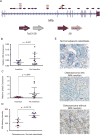A Genome-Wide Scan Identifies Variants in NFIB Associated with Metastasis in Patients with Osteosarcoma
- PMID: 26084801
- PMCID: PMC4560660
- DOI: 10.1158/2159-8290.CD-15-0125
A Genome-Wide Scan Identifies Variants in NFIB Associated with Metastasis in Patients with Osteosarcoma
Abstract
Metastasis is the leading cause of death in patients with osteosarcoma, the most common pediatric bone malignancy. We conducted a multistage genome-wide association study of osteosarcoma metastasis at diagnosis in 935 osteosarcoma patients to determine whether germline genetic variation contributes to risk of metastasis. We identified an SNP, rs7034162, in NFIB significantly associated with metastasis in European osteosarcoma cases, as well as in cases of African and Brazilian ancestry (meta-analysis of all cases: P = 1.2 × 10(-9); OR, 2.43; 95% confidence interval, 1.83-3.24). The risk allele was significantly associated with lowered NFIB expression, which led to increased osteosarcoma cell migration, proliferation, and colony formation. In addition, a transposon screen in mice identified a significant proportion of osteosarcomas harboring inactivating insertions in Nfib and with lowered NFIB expression. These data suggest that germline genetic variation at rs7034162 is important in osteosarcoma metastasis and that NFIB is an osteosarcoma metastasis susceptibility gene.
Significance: Metastasis at diagnosis in osteosarcoma is the leading cause of death in these patients. Here we show data that are supportive for the NFIB locus as associated with metastatic potential in osteosarcoma.
©2015 American Association for Cancer Research.
Conflict of interest statement
The authors declare no competing financial interests.
Figures





Similar articles
-
Genetic Variant of NFIB is Associated With the Metastasis of Osteosarcoma in Chinese Population.Technol Cancer Res Treat. 2019 Jan 1;18:1533033819874802. doi: 10.1177/1533033819874802. Technol Cancer Res Treat. 2019. PMID: 31522615 Free PMC article.
-
Genome-wide association study identifies the GLDC/IL33 locus associated with survival of osteosarcoma patients.Int J Cancer. 2018 Apr 15;142(8):1594-1601. doi: 10.1002/ijc.31195. Epub 2017 Dec 23. Int J Cancer. 2018. PMID: 29210060 Free PMC article.
-
Genome-wide association study identifies two susceptibility loci for osteosarcoma.Nat Genet. 2013 Jul;45(7):799-803. doi: 10.1038/ng.2645. Epub 2013 Jun 2. Nat Genet. 2013. PMID: 23727862 Free PMC article.
-
[Molecular characterization of osteosarcomas].Pathologe. 2013 Nov;34 Suppl 2:260-3. doi: 10.1007/s00292-013-1823-9. Pathologe. 2013. PMID: 24196625 Review. German.
-
Systematic meta-analysis of genetic variants associated with osteosarcoma susceptibility.Medicine (Baltimore). 2018 Sep;97(38):e12525. doi: 10.1097/MD.0000000000012525. Medicine (Baltimore). 2018. PMID: 30235774 Free PMC article. Review.
Cited by
-
LncRNAs as potential prognosis/diagnosis markers and factors driving drug resistance of osteosarcoma, a review.Front Endocrinol (Lausanne). 2024 Jul 2;15:1415722. doi: 10.3389/fendo.2024.1415722. eCollection 2024. Front Endocrinol (Lausanne). 2024. PMID: 39015175 Free PMC article. Review.
-
CEP55, serving as a diagnostic marker gene for osteosarcoma, triggers the JAK2-STAT3-MMPs axis.Ann Med Surg (Lond). 2023 Nov 7;86(1):190-198. doi: 10.1097/MS9.0000000000001491. eCollection 2024 Jan. Ann Med Surg (Lond). 2023. PMID: 38222763 Free PMC article.
-
Genetically inferred birthweight, height, and puberty timing and risk of osteosarcoma.Cancer Epidemiol. 2024 Oct;92:102432. doi: 10.1016/j.canep.2023.102432. Epub 2023 Aug 16. Cancer Epidemiol. 2024. PMID: 37596165
-
Downregulation of miR-182-5p by NFIB promotes NAD+ salvage synthesis in colorectal cancer by targeting NAMPT.Commun Biol. 2023 Jul 25;6(1):775. doi: 10.1038/s42003-023-05143-z. Commun Biol. 2023. PMID: 37491379 Free PMC article.
-
Children's Oncology Group's 2023 blueprint for research: Epidemiology.Pediatr Blood Cancer. 2023 Sep;70 Suppl 6(Suppl 6):e30566. doi: 10.1002/pbc.30566. Epub 2023 Jul 14. Pediatr Blood Cancer. 2023. PMID: 37449937 Free PMC article.
References
Publication types
MeSH terms
Substances
Grants and funding
LinkOut - more resources
Full Text Sources
Other Literature Sources
Medical
Molecular Biology Databases

